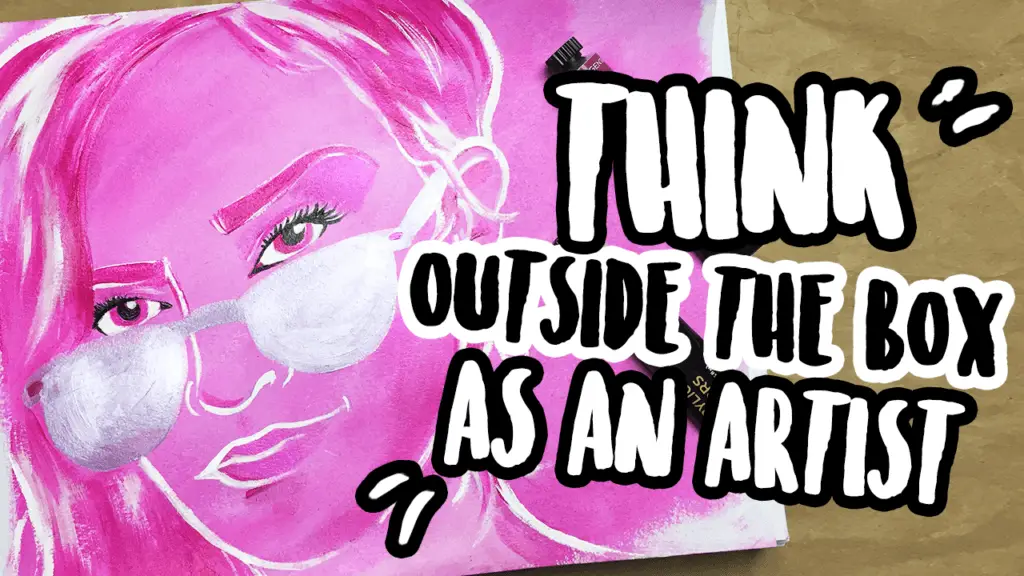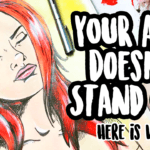The 4 simple steps to becoming a better creative thinker and getting more unique “out-of-the-box” ideas with your art
Ever felt you were only good at one thing with your art and felt incredibly hesitant to try anything new?
You pine for more out-of-the-box creativity, but find yourself stuck in a spiraling circle of fear and uncertainty. What if I mess up? What if I fail? I just gathered courage to make something I like, will I be able to handle more self-criticism?
If you are an artist or creative, you probably have experienced the classic reluctance for change and trying new things with your art.
…and let me preface this by saying, you are definitely not alone.
Watch my full video below on how to think outside the box as an artist!
Plenty of artists find themselves in this sort of creative rut, where they only create one thing they know they are good at, and find little to no impetus to creatively explore anything different.
Change is hard – especially when we know we are really good at something and don’t want to veer out of our lanes. But, as much as that upside is nice, it also has its major faults.
If we don’t adapt and try new art styles, we stagnate and begin to lose our creative edge. And the way to light a fire under our butts to do this is first, checking in with ourselves and understanding why we feel the way we do.
Part 1: Tap into your WHY for being hesitant
As silly as this sounds, a big part of art is overcoming the mental barriers we place on ourselves in the creation process. The sooner we can understand WHY we feel the way we do, the sooner we can move on. This exercise might be a bit raw but will really allow yourself to be honest.
Why are you afraid to create different things? Are you fearful that trying something new will lead to failure? Or that you hate feeling out-of-place and uncertain?
Really dig deep with your emotional triggers and try to get to the root of why you feel so fearful. Understanding that can help you wipe out the excuses you mentally place on yourself and begin the healing process of moving forward.

Part 2: Tap into your WHY for creating art

Once you’ve dug deep (and destroyed all your box of tissues from all your breakthroughs), think about WHY you love making art. What compels you to want to create art in the first place? Does it relax you? Does it help you be a better person?
Related: Finding your Creative Why
Understanding your WHY is crucial, because it constantly reminds us to feed our emotional and creative soul – knowing what it wants helps us make the hard changes that we NEED to make.
When thinking about your why, really take the time to explore. Everyone has a different reason for doing what they do, and it always always ALWAYS comes from an emotional place.
For example, my WHY for making art is to leave a lasting impression on the world so I feel I made a difference – this mission keeps me fired up day after day – and in a way, forces me to be creative and to constantly try new things lol.
Once you’ve found your WHY, write it down on a notepad or sticky note, and make sure you place that note somewhere you can see it everyday so it serves as a constant reminder to you.

How does one think outside-the-box?
The very subject of creative thinking is super fascinating to me, partly because I myself am a huge process improvement nerd, but mainly because creative thinking is the birthplace of unique thought and innovation.
If you recall from my previous post, Why Art is Important, I touched on how art is the pulse of society – a tool for constantly interpreting the world around us and creating quiet revolutions that in turn help shape society. This is done with the power of creative thinking.
And how does one think creatively? Well, creative thinking requires set of factors to ensure its success in our lives. The two most important being the following:
- Create a safe, open minded environment mindset
- Learn the rules and then break them!
When these two factors are in play, the field of open, creative thinking is born, and we become free to explore and make changes.

How to think outside-the-box with art?
So, now that we know about the foundation of creative thinking, we can also apply this to the world of art with just 4 steps:
Step 1: Allow yourself the freedom to brainstorm
This is definitely a mindset exercise and a necessary one at that!
Think about it.
If you don’t allow yourself the freedom to explore new ideas without constant criticism, you are severely limiting yourself and your imagination to take over. Experienced artists understand the important of free thought and how even the most ridiculous ideas can be somehow applied to their work.
How do you think the iPhone was born?
The concept of a supercomputer you can carry in your pocket was NUTS back before the age of smartphones. But, Steve Jobs, the creator of Apple, found the most innovation in his engineers when he challenged them to accept that no idea was a bad idea in the initial creation process.
It was a super ridiculous (nay-laughable!) notion that a portable small computer was somehow achievable. And as crazy as it sounded, it worked, and Apple cornered the market as a titan of tech innovation as a result of this.
The same applies to us as artists. Keep an open mind, look at every idea that pops in your head as viable and do not immediately dismiss it because it sounds too silly. From one idea, another idea can be born.

Step 2: Define your art process and replace one aspect with something different
I like to call this Art Madlibs, where you replace one word in a sensible process or sentence with something different and unique.
How would that work?
A great way to really push the bounds on your skills and comfort zone is to first define your process steps when making art and understand the rules you place on yourself when in the creation process.
Once you got something down, think about replacing one step in the process or tool with something else.
For example, my process for creating my pop art goes something like this….
- Collect my brushes, acrylic paint, water, and canvas.
- Choose my model topic – let’s say I chose a girl with glasses
Now it’s time to play Madlibs….
I choose one item in my process and replace it with something else.
For example….
- replace brushes with finger painting
- replace acrylic paint with condiments
- replace the girl’s face with an elephant
- replace the girl’s glasses with a comb
You getting my point?
Once you have a slew of ideas, you can proceed to step 3 which is….

Step 3: Pull the Threads and Discover
From here, you can really go to town (if you choose to go further).
For example, if I am really liking the idea of replacing the girl’s face with an elephant face wearing glasses, I can either paint that or keep idea generating.
An elephant face holding a melting popsicle trying to feed a mouse.
It’s strange. It’s funny. And totally an original idea you NEVER would have thought to do otherwise. Plus, this is a great example of how one crazy silly idea helped beget another.
Step 4: Assess Your Ideas and Pair Down
So you got a slew of great ideas. You may start having trouble STOPPING all those good ideas. This is really good and don’t forget to write all of them down for future reference!
But now it’s time to put back on our critical hats and assess what we would like to actually do for a drawing/painting. It’s OK at this point to be critical because you already poured out a ton of ideas and now need the analytical mind to pair down and realistically choose what is feasible for you to make.
Once you have your idea picked, you are now ready to rock and roll!

You got your idea, now go!
When it comes to the actual process of painting/drawing, if you’re still feeling a bit nervous, you may want to start small. And that is OK. Start small. Experiment. You don’t have to make a huge painting or do stuff on a canvas if you’re not quite ready yet.
If you don’t want to use expensive materials, use cheaper materials. For example, I like to play around with multi-media paper when trying out a new technique. I dunno why, but using multimedia paper (especially this one) just takes out all the pressure of having to make something perfect all the time lol!
Do this multiple times and then, move onto something bigger – a canvas or a larger surface. And practice again.
Read More: How to Be Motivated to Create Art
Whatever you do, don’t stop being silly in your creation process and make notes of what you like and don’t like. This whole process is your experiment time – take advantage of it!
Plus, you never know… you might invent a whole new technique you never thought you would like!
What did you think of these tips? How do you think out-of-the-box and get out of your creative slump? Comment below and let me know!





